BEFORE THE AMERICAN REVOLUTION THERE WERE 12 BRITISH COLONIES AND 1 MILITIA OF JESUS PLANTATION! AT THE LAST SUPPER IN OLD JERUSALEM, 12 DISCIPLES SAT DOWN WITH MESSIAH JOSHUA BEN DAVID; JUDAH ISCARIOT WAS NUMBER 13. (ST. MATT. 26:20, ST. MARK 14:17, ST. LUKE 22:14, ST. JOHN 13:21). |
Ominously, this year is the 490th anniversary of the founding of the Militia of Jesus, and the 390th anniversary of the founding of the Maryland Plantation. The angel Gabriel told Daniel the Prophet that 490 years (7x70) were determined upon Old Jerusalem (Daniel 9:24).
The 12 colonies were: New Hampshire, Massachusetts, Rhode Island, Connecticut, New York, New Jersey, Delaware, Pennsylvania, Virginia, North Carolina, South Carolina, Georgia. Adding the Militia of Jesus Plantation makes 13. In the Book of Esther, 13 was the number for the planned holocaust or extermination of Israel (Esther 3:13).
The star spangled banner that flew over Fort McHenry in Baltimore, Maryland, had 15 stripes until it was reduced to 13 in 1818.
George Calvert, 1st Baron Baltimore (1580–1632), was an Irish peer who tried to set up a colony in Newfoundland. That colony was a failure, so King Charles I issued a new chanter for a plantation in the Chesapeake area of Virginia. King James I had already "donated" that location to the Virginia Company.
Almost the same time as Saint John Winthrop was establishing New Boston as a "shining city on a hill," the Militia of Jesus established the Maryland Plantation in a bold challenge to reborn Israel in the wilderness!
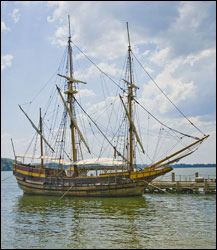 A replica of the Maryland Dove. |
|
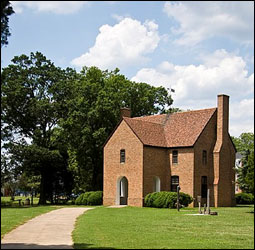 Replica of the first Maryland capital Replica of the first Maryland capital known as St. Mary's City. |
Cecil Calvert, 2nd Baron Baltimore, was appointed proprietor of the plantation . . . but he never left England.
King Charles I ignobly advanced the Thirty Years War (1618–1648) triggered by his father James I. That deadly conflict devastated Europe and killed millions of Reformed Christians!

King Charles
I (1600–1649).
Misruled from 1625 to 1649. |
|
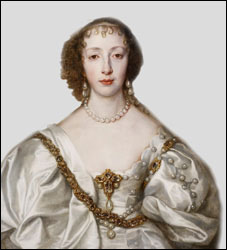
Portrait of Queen Henrietta-Maria
(1609–1669). |
Calvert stayed behind in England and worked closely with his fellow Jesuits coordinating the St. Bartholomew's Day Massacre in his native land!
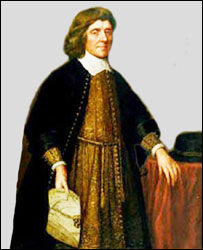 Cecil Calvert, 2nd Baron Baltimore (1605–1675). |
|
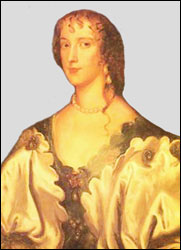 Anne Arundel Calvert (1616–1648). |
In the Book of Daniel Chapter 7, the Prophet saw 4 terrifying beasts emerging from the sea. The first was like a lion, followed by a bear, and then a leopard. The nondescript 4th beast was unlike anything he had ever seen in the zoo in Babylon.
The Apocalypse is a continuation of the Book of Daniel. Saint John specifically noticed 3 wild animals associated with the beast from the sea: LEOPARD, BEAR, and LION, None of those beasts are indigenous to Britain, but bear baiting was a very popular blood sport from the 12th to the 19th century.
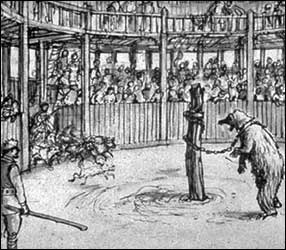 Bear baiting was a popular blood sport in Elizabethan England. |
|
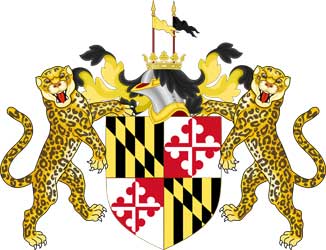 The coat-of-arms issued to Cecil Calvert in London. |
In the Book of Daniel the leopard symbolized Alexander the Great who set out with a small army to conquer the entire world. Everyone knows that the British lion has been fighting the Russian Bear since the days of the Elizabeth double. The leopard cannot change his spots (Jeremiah 13:23) and the British Empire cannot cease from acting beastly toward the entire world!
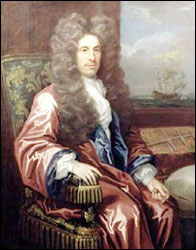 Charles Calvert, 3rd Baron Baltimore (1637–1715). |
|
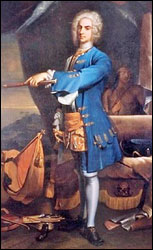 Charles Calvert, 5th Baron Baltimore (1699–1751). |
Charles Calvert, 3rd Baron Baltimore, and the 5th Baron, were the nominal rulers of the Maryland fiefdom during the momentous years following the Glorious Revolution.
Their plantation charter was abolished by William and Mary in 1698, but restored by King George I in 1715. It was a precursor to the death and resurrection of the Militia of Jesus.
Charles the Schemer was the founder of the Carroll dynasty in Maryland
In July 1688, King James II appointed Charles the Schemer as attorney general of Maryland. He arrived in the plantation in October. On November 5th the king fled to France with Queen Mary Beatrice and the warming pan baby. The English Civil War did not end with the death of Oliver Cromwell.
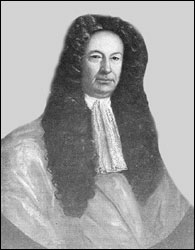
Charles
Carroll the Schemer
(1661–1720). |
|
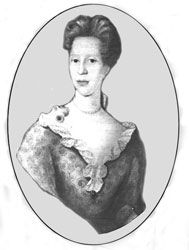 Mary Durnall Calvert (1678–1742). |
The Schemer had 10 children with Mary, but 5 died within a year of their birth. 3 boys and 2 girls survived. The Schemer sent his eldest boy Henry to London to study with the British Jesuits, but he went to "Purgatory" on the voyage back to the plantation in 1719.
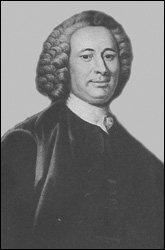
Charles Carroll of Annapolis
(1702–1782). |
|
 Charles Carroll of Carrollton (1737–1832). |
Charles Carroll of Carrollton went to "Purgatory" exactly 100 years after baby George Washington arrived in Virginia....At aged 15 his father sent him to the Jesuit seminary in Liége, Belgium, to begin his very long indoctrination for the Jesuit priesthood.
The vast Carroll fortune came from tobacco harvested by thousands of slaves!!
King James I actually wrote a treatise entitled A Counterblaste To Tobacco, in which he condemned smoking the weed.
The tobacco craze was the counterpart to the opium addiction in China. The British East India Company had almost the entire population hooked on heroin. That deadly drug was outlawed in Britain . . . but not tobacco smoking!
Tobacco was first grown in the Virginia colony, but then it was discovered that the Chesapeake area of Maryland was ideal for growing the weed.
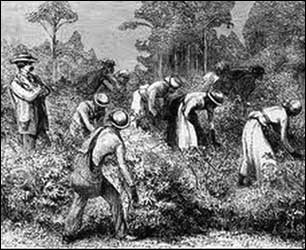
Slaves harvesting tobacco on
the Maryland plantation. |
|
 Tobacco was packed into huge barrels called hogsheads and shipped to London. Tobacco was packed into huge barrels called hogsheads and shipped to London. |
The Bank of England financed the distribution and sale of the weed throughout Europe. It was a financial windfall, and the source of the leopard's funding for the Seven Years' War and the American Revolution.
If only a true history of the Bank of England was written people would be shocked at the leopard's double-dealing!
The marriage of the Calvert and Washington fortunes occurred in 1774
George Washington was not heir conditioned and that fact changed the course of New World history. He married widow Martha in 1758, and she had 4 children with her former husband, Daniel Parke Custis.
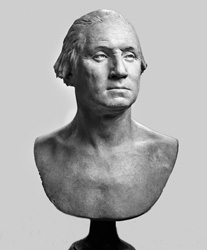 Bust of "Saint George " Washington (1731–1799). |
|
 Martha Washington (1731–1802). |
The Calverts and Carrolls were the richest families in Maryland. They were always screaming about religious discrimination, but that did not stop them from amassing their huge fortune. Obviously, they never considered that their slaves were suffering discrimination by working for nothing!
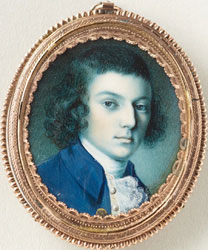 John Parke Custis (1754–1781). |
|
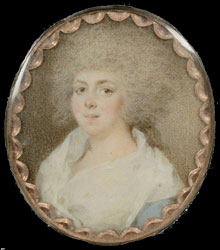 Eleanor Calvert Custis (1758–1811). |
Martha Washington had an account at the Bank of England, and she received usury checks every month during the Revolution! The bank kept a record of those payments, but there is no record of her husband's vast fortune safely deposited in the Bank.
A "smoking gun" connects the Bank of England with the Revolution!
Slaves can be forced to work for nothing, but even ardent "patriots" expect to be paid....The most fanatical Boche and Nazis did not fight for Kaiser and Führer for free!
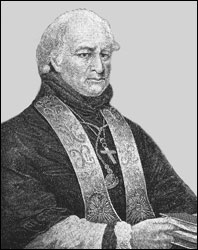 John Carroll, S.J. (1735–1815). |
|
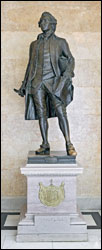 Statue of Charles Carroll in the Capitol, with pen in hand. |
The American Revolution did indeed cost a colossal sum:
Money speaks with a might voice in all revolutionary movements. The entry of Charles Carroll of Carrollton brought great prestige to the Continental Congress, buoying the American heart and dismaying the enemies of American rights. In his book containing the Carroll-Dulany letters, published by the State of Maryland in 1902, Elihu S. Riley informs us that at the beginning of the Revolution Carroll "was worth $20,000,000," a colossal sum in those days. He was the richest man in the colonies. (Gurn, Charles Carroll of Carrollton, p. 83).
In today's dollars that would amount to the titanic sum of $375,000,000, or £269,884,478. There were no banks in the colonies so that fabulous fortune was deposited in the Bank of England.
Maryland bore the brunt of the fighting and the expenses. After the Revolution the legislature sent Samuel Chase to London to negotiate with the Bank of England for the release of funds that had been frozen during the Revolution:
Prior to the war, Maryland had invested the sum of twenty-seven thousand pounds sterling in the stock of the Bank of England. During the Revolution, the legislature had drawn bills of credit upon the trustees for the amounts of the dividends which had been uniformly protested. They now appointed an agent, Samuel Chase, to proceed to England and recover the amount of the accumulated dividends and to sell the stock, for the purpose of honestly meeting their liabilities as speedily as possible. Difficulties and disputes arose, and a considerable period elapsed before success crowned the efforts of the agent. (McSherry, History of Maryland, p. 397).
Samuel Chase was another arch intriguer and a signer of the Declaration of Independence!
The newborn Republic was supposed to be temporary until the leopard returned!
If George Washington was heir conditioned he would have been crowned king right after the "pretended surrender" of Lord Cornwallis. Instead of a "tyrant" 3000 miles away, the "patriots" would have to deal with a Catholic tyrant right in their midst.
The leopard returned with a vengeance in 1814 and burned the White House to the ground. Then the beast attempted to devour Baltimore. The land invasion failed and the Star-Spangled Banner was written during the siege of Fort McHenry which protected the seaward entrance to the city.
That invasion was just a feint as the leopard's real destination was New Orleans.
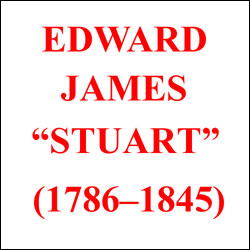 Edward James "Stuart" was the proposed king for the new "Holy Roman" Empire States of America! |
|
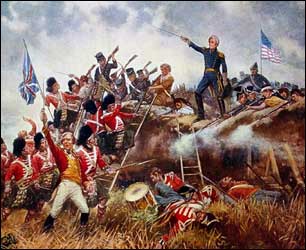 General Jackson and his militia chased General Jackson and his militia chased the leopard back into the sea. |
Battles do change the course of world history. The Battle of Gettysburg changed the course of world history. The great victory of the Marines at Belleau Wood changed the course of world history. The great victory of the Russians at Stalingrad changed the course of world history.
Charles Carroll was bitterly disappointed by General Jackson's great victory at New Orleans:
Six months before Waterloo the war between Britain and the United States was terminated by the Treaty of Ghent, signed on December 24, 1814. This instrument, signed in Belgium, was sealed as it were, at New Orleans on January 8, 1815, by General Jackson's momentous victory. A new and glorious era for the United States had now begun. But Charles Carroll could not get rid of his pessimism. "I say nothing of politics," he declared in the fall of 1816. "Indeed I hate to think of them," for in viewing the general complexion and temper of these United States I see nothing to console but much to alarm me for the present and future welfare of my country." (Gurn, Charles Carroll of Carrollton, p. 212).
13 men entered the Upper Room for the Last Supper in Old Jerusalem!
The Messiah and his 12 disciples entered the Upper Room for a farewell supper the day before the Passover. Passover fell on a Wednesday of that year, or the Third of the Sabbaths in the Hebrew 7-day week.
And the disciples did as Joshua had directed them; and they prepared the Passover. Now when the evening was come, he sat down with the twelve. And as they did eat, he said, "verily I say unto you, that one of you shall betray me" (Saint Matthew 26:23-24).
It wasn't the looming crucifixion that upset the Messiah as much as the fact that there was a traitor in their midst. Judah Iscariot was the treasurer, and extremely stealthy, as none of the disciples ever suspected him of treason!
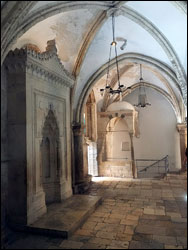 The traditional site of the Upper Room in Old Jerusalem. |
|
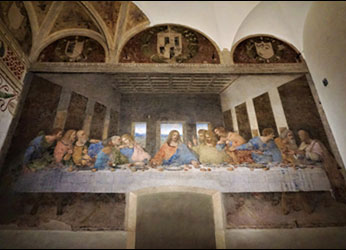 The Last Supper, by Leonardo da Vinci. |
The Messiah called Judah Iscariot the Son of Perdition:
While I was with them in the world, I kept them in thy name: those that thou gavest me I have kept, and none of them is lost, but the son of perdition (Gk. apoleia) that the Scripture might be fulfilled (Saint John 17:12).
The English word PERDITION is derived from the Greek name Apollyon, who is the Angel of the Bottomless Pit (Apocalypse 9:11).
When "Moneybags" Judah Iscariot left only 12 men remained in the Upper Room....Saint Paul calls the Antichrist the Son of Perdition:
Let no one deceive you by any means; for that day will not come unless the apostasy (Gk. apostacia) comes first, and the Man of Sin is reveled, the Son of Perdition, who opposes and exalts himself above all that is called Elohim, or that is worshiped, so that he sits as Elohim in the temple of Elohim, showing himself that he is Elohim (II Thessalonians 2:3).
All the Reformers applied that Scripture to the Papal dynasty. The teaching that a future "Antichrist" will sit in a rebuilt temple in Old Jerusalem is a Militia of Jesus smokescreen . . . and pure fantasy!
Saint Paul told the Christians distinctly that they were the Temple of Elohim:
Do ye not know that ye are the temple of Elohim and that the Spirit of Elohim dwells in you? If anyone defiles the temple of Elohim, Elohim will destroy him. For the temple of Elohim is holy, which temple ye are (I Corinthians 3:16-17).
Old Jerusalem is gone with the wind, and the prophetic scene shifted to the West and the New World after the fall of Babylon on the Tiber:
And he that sat upon the throne said "behold, I make all things new" (Apocalypse 21:5).
Vital links
References
Guilday, Peter. The Life and Times of John Carroll, Archbishop of Baltimore. The Newman Press, Westminster, Maryland, 1922 & 1954.
Gurn, Joseph. Charles Carroll of Carrollton, 1737–1832. P.J. Kennedy & Sons, New York, 1932.
Haw, James. Stormy Patriot: The Life of Samuel Chase. Maryland Historical Society, Baltimore, Maryland, 1980.
Hedberg, Jacqueline Simmons. Plantations, Slavery & Freedom on Maryland's Eastern Shore. HIstory Press, Charleston, South Carolina, 2019.
Hoffman, Ronald. Princes of Ireland, Planters of Maryland. University of North Carolina Press, Chapel Hill, North Carolina, 2000.
Ives, Joseph Moss. The Ark and the Dove:The Beginning of Civil and Religious Liberties in America. Longmans. Green and Company, New York, 1936. (A very rare Jesuit tome about the founding of Maryland).
Lossing, Benson J. Biographical Sketches of the Signers of the Declaration of Independence. J. C Derby, Boston & Philadelphia, 1854.
McSherry, James. History of Maryland from its first Settlement in 1634 to the Year 1848. Baltimore Book Company, Baltimore, Maryland, 1904.
Middleton, Arthur Pierce. Tobacco Coast: A Maritime History of the Chesapeake Bay in the Colonial Era. Johns Hopkins University Press, Baltimore, MD, 1984.
Copyright © 2024 by Patrick Scrivener